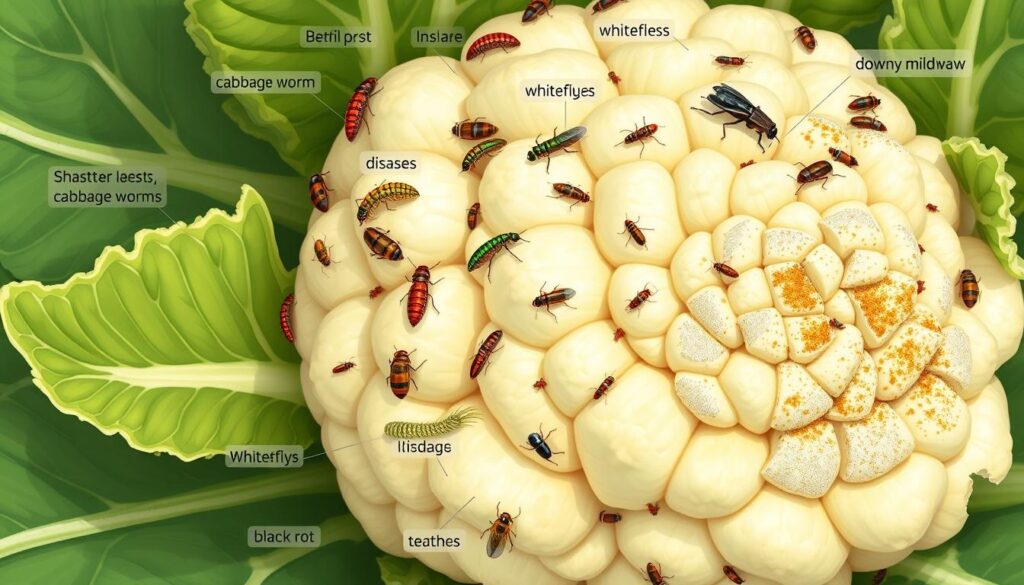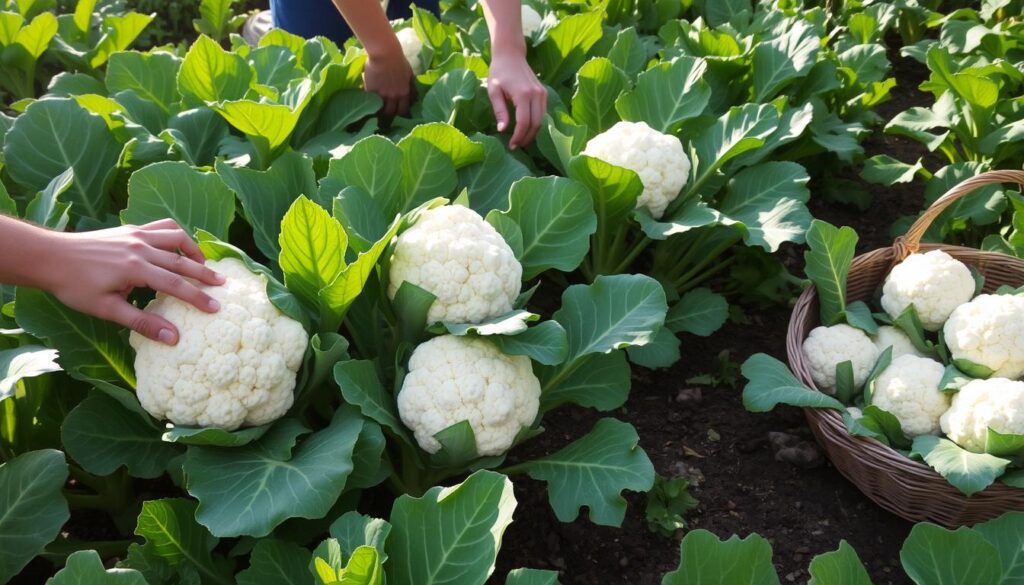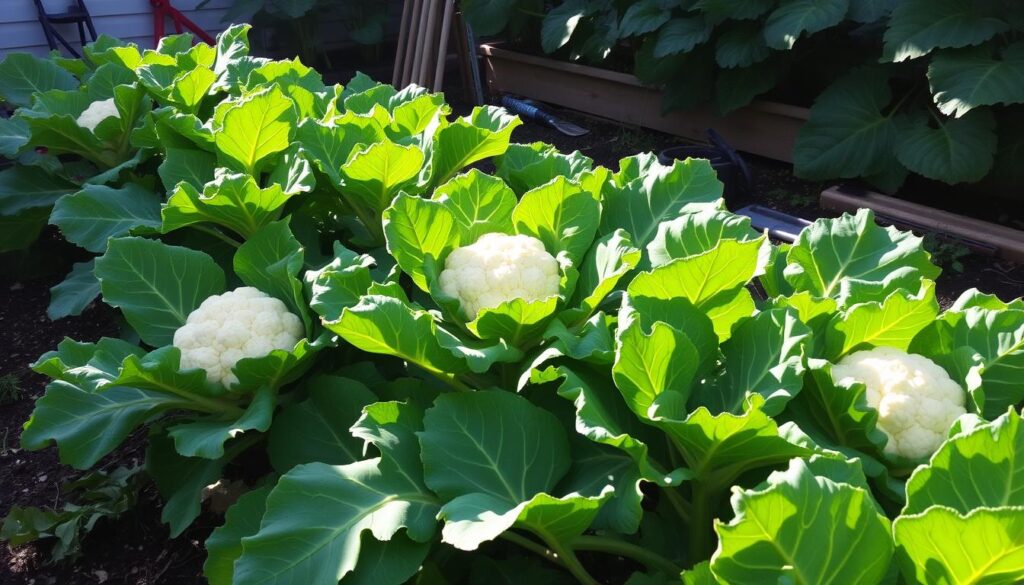Welcome to our guide on growing cauliflower at home. We’ll cover everything you need to know to grow perfect cauliflower. Growing cauliflower can be rewarding, and with the right guidance, you can enjoy a bountiful harvest.
Whether you’re new to gardening or have experience, this guide is for you. We’ll take you through growing cauliflower, from choosing the right variety to harvesting. Our aim is to give you a step-by-step guide to growing cauliflower at home.
In this guide, we’ll cover the essential topics to help you start growing cauliflower. We’ll talk about the basics and give tips for a healthy crop. By the end, you’ll know how to grow delicious cauliflower at home.
Key Takeaways
- Learn the basics of how to grow cauliflower at home
- Discover the best varieties of cauliflower for home growing
- Understand the importance of proper soil preparation for growing cauliflower
- Get tips on how to maintain a healthy cauliflower crop
- Learn how to harvest cauliflower at the right time for maximum flavor and nutrition
Introduction to Growing Cauliflower
Growing cauliflower at home can be very rewarding. It gives you fresh, healthy food and a sense of pride. To start, you need to know about planting tips and the best soil for cauliflower. With the right info, you can grow lots of tasty and nutritious cauliflower.
Choosing the right cauliflower variety is key. There are many types, each with its own needs and looks. Some favorites are Snow Crown, White Corona, and Graffiti. Knowing about these varieties helps you pick the best one for your area.
Why Grow Your Own Cauliflower
There are many benefits to growing your own cauliflower. You get fresh, healthy food and control over how it’s grown. By following planting tips and using the best soil, you can grow a great crop. Plus, it’s a fun way to connect with nature and enjoy your hard work.
Different Varieties of Cauliflower
There are many cauliflower varieties to choose from. Each has its own look and growing needs. Here are a few popular ones:
- Snow Crown: Known for its big, white heads and mild taste.
- White Corona: Produces large, white heads and tastes sweet.
- Graffiti: Has purple, orange, and white heads, adding color to any dish.
Understanding the Growing Season
Knowing the growing season is important for your cauliflower. It helps ensure your plants get enough sunlight, water, and nutrients. By following planting tips and using the best soil, you can grow a lot of delicious cauliflower.
Essential Growing Requirements for Cauliflower
To grow healthy cauliflower plants, knowing the essential growing requirements is key. Cauliflower needs full sun, well-draining soil, and enough water. The sun requirements for cauliflower are specific. Most varieties need at least 6 hours of direct sunlight daily.
Cauliflower plants prefer soil with a slightly acidic to neutral pH, between 6.0 and 7.0. The soil should also be rich in nutrients like nitrogen, phosphorus, and potassium. Proper soil preparation is vital for the plants to grow well.
By following these guidelines, you can create the best environment for your cauliflower plants to thrive.
Selecting the Perfect Location for Your Cauliflower Patch
When growing cauliflower at home, picking the right spot is key. Cauliflower needs full sun to grow well. Find a place that gets at least six hours of direct sunlight each day.
Temperature is also important. Cauliflower doesn’t like extreme weather. Plant it in a spot that’s safe from strong winds and has good air flow. The soil should be well-draining and full of nutrients.
Sunlight Requirements
To get the right sunlight for your cauliflower, follow these tips:
- Choose a location that gets direct sunlight for at least six hours a day
- Avoid planting cauliflower in shaded areas, as this can lead to weak and spindly growth
- Consider using row covers or other shading materials to filter the sun’s rays if you live in a very hot climate
Temperature Considerations
Cauliflower grows best in cool temperatures, between 60°F and 75°F. Avoid planting in extreme weather. It can harm the plants and lower yields.
How to Grow Cauliflower: Step-by-Step Guide
Growing cauliflower can be very rewarding. It’s best to start with the right cauliflower planting tips. First, decide if you want to start seeds indoors or directly in your garden. If indoors, plant seeds 4-6 weeks before the last frost.
When your seedlings have 4-5 leaves, it’s time to move them to bigger containers or the garden. Harden off the seedlings before moving them outside to avoid shock. Direct sowing is also possible, but the soil must be warm and frost-free. Keep an eye out for the right time to pick your cauliflower.
Starting Seeds Indoors
- Plant seeds 4-6 weeks before the last frost date
- Keep the soil warm and moist
- Provide adequate light for the seedlings
Direct Sowing Methods
Direct sowing can be a bit tricky, but it’s doable with the right conditions. Make sure the soil is warm and there’s no risk of frost before sowing seeds directly in the garden.
Transplanting Tips
When transplanting, handle seedlings gently and avoid disturbing the roots. With the right cauliflower planting tips and patience, you’ll enjoy a bountiful harvest. Harvesting cauliflower will become a fun and rewarding experience.
Soil Preparation and Requirements
To grow healthy cauliflower, you need to prepare the soil right. Cauliflower thrives in well-draining, fertile soil that’s rich in organic matter. The best pH for cauliflower is between 6.0 and 7.0.
Start by adding compost or well-rotted manure to the soil. This improves its structure and fertility. Make sure to remove any debris or rocks that could harm the roots. Cauliflower needs plenty of nutrients, so keep feeding it throughout the season. Here are some key tips for soil preparation:
- Test the soil’s pH to make sure it’s in the right range
- Add organic matter like compost or manure to boost fertility
- Clear out debris and rocks to help roots grow
By following these steps and using the best soil, you’ll create a great environment for your cauliflower.
Proper soil preparation is key to growing healthy cauliflower. With the right soil, you’re on your way to a successful harvest. Well-draining soil is very important. It prevents waterlogged soil that can cause root rot and other issues.
Watering Your Cauliflower Plants
Watering your cauliflower plants right is key for their health, when they’re making heads. They need steady moisture, getting about 1-2 inches of water weekly. This can come from rain or a hose. Always check the soil to prevent too much water, which can harm the roots.
Knowing how much sun your cauliflower needs is also important. They do best in full sun but need water to stay healthy. Water them when the top inch of soil feels dry.
Watering Schedule
Having a good watering plan can help you avoid mistakes. Here are some tips to remember:
- Water your cauliflower deeply once or twice a week, based on the weather.
- Don’t let water hit the leaves or crown to avoid disease.
- Use a soaker hose or drip irrigation to water the roots directly.

Signs of Over and Under Watering
Knowing the signs of too much or too little water is key. Overwatering shows as yellow leaves and soft stems. Underwatering makes plants stressed, leading to bad head growth.
Fertilizing and Feeding Guidelines
When growing cauliflower at home, it’s key to give your plants the right nutrients. Cauliflower needs a lot of food to grow well. Use a fertilizer that has nitrogen, phosphorus, and potassium. Follow the instructions on the fertilizer package to avoid too much.
For cauliflower care instructions, think about using a fertilizer high in nitrogen. This helps the leaves grow strong and the head to form well. Organic fertilizers like compost or manure are also good for your plants.
- Start with a balanced fertilizer and adjust as needed
- Avoid overfertilizing, as this can damage your plants
- Consider using organic fertilizers for a natural source of nutrients
By following these cauliflower care instructions and giving your plants the right food, you’ll grow healthy, tasty cauliflower at home.
Common Cauliflower Pests and Diseases
Cauliflower is a tasty and healthy veggie, but it faces pests and diseases. Knowing these issues helps grow a healthy crop. Regular checks and quick action are key to stopping problems.
Pests like aphids, whiteflies, and flea beetles harm cauliflower. They damage leaves and flowers, cutting down your harvest. Keep your garden clean, remove weeds, and ensure good air flow. Use natural treatments like neem oil and insecticidal soap to fight pests.

Cauliflower also faces diseases like powdery and downy mildew. These diseases turn leaves yellow, create black spots, and cover flowers with a white powder. Good air flow, watering at the base, and avoiding overhead watering help prevent disease. These tips can help keep your cauliflower healthy.
Identifying Common Pests
- Aphids: small, soft-bodied insects that feed on plant sap
- Whiteflies: tiny, winged insects that feed on plant sap
- Flea beetles: small, jumping insects that feed on plant leaves
Disease Prevention
To prevent disease, make sure to:
- Provide adequate air circulation
- Water your plants at the base
- Avoid overhead watering
Natural Treatment Methods
Some natural ways to fight pests and diseases in cauliflower include:
- Neem oil: a natural insecticide that can be used to control pest populations
- Insecticidal soap: a mild detergent that can be used to control pest populations
Maintaining Healthy Cauliflower Plants
To keep your cauliflower plants healthy, give them the right water, nutrients, and sunlight. Check your plants often for signs of stress, disease, or pests. Act quickly if you find any issues. By following cauliflower care instructions, your plants will grow well and give you tasty heads.
When growing cauliflower at home, keep the area around your plants weed-free. This helps them get enough water and nutrients. Here are some tips to remember:
- Water your plants regularly, but don’t overdo it to avoid disease and root rot.
- Use a balanced fertilizer to help your plants grow strong and healthy.
- Watch out for pests and diseases and deal with them fast to stop them from spreading.
By following these tips and caring for your cauliflower plants, you’ll get a big harvest. Enjoy your home-grown cauliflower.
Blanching: Why and How to Do It
Harvesting cauliflower involves a key step: blanching. This method keeps the cauliflower’s color and texture fresh. By learning the benefits and how to blanch, you’ll have a great cauliflower harvest.
Blanching stops light from reaching the cauliflower heads. This prevents chlorophyll from forming and keeps the cauliflower white. To blanch, tie the leaves together with twine or a rubber band. Do this when the heads are 6-8 inches wide.
Benefits of Blanching
Blanching has many advantages. It keeps the cauliflower’s color and texture, reduces spoilage, and boosts harvest quality. By planting cauliflower correctly, you’ll enjoy your homegrown cauliflower for months.
Step-by-Step Blanching Process
To blanch cauliflower, just follow these steps:
- Tie the leaves together with twine or a rubber band, excluding all light.
- Check the cauliflower regularly to ensure the leaves are tied and the heads are not over-maturing.
- Blanching can take 7-14 days, depending on the variety and weather.

By following these steps and blanching your cauliflower, you’ll have a successful harvest. Enjoy your delicious, homegrown cauliflower. Always follow the best cauliflower planting tips for the best results.
| Blanching Time | Variety | Weather Conditions |
|---|---|---|
| 7-10 days | Early-season varieties | Mild weather |
| 10-14 days | Late-season varieties | Cooler weather |
When and How to Harvest Cauliflower
Harvesting cauliflower is a thrilling moment for gardeners. It’s key to do it at the right time for the best taste and texture. Check if the cauliflower heads are firm and the buds are closed tight. This step is vital in cauliflower care, as it impacts the quality of your harvest.
When your cauliflower is ready, use a sharp knife to cut the head from the plant. Leave a small stem attached. Handle the heads carefully to avoid bruising, which can lower their quality. After harvesting, keep the cauliflower in a cool, dry spot to keep it fresh.
Signs of Readiness
- The head is firm and compact
- The buds are tightly closed
- The color is a deep white or cream
Proper Harvesting Techniques
To harvest cauliflower correctly, follow these steps:
- Cut the head from the plant, leaving a small portion of stem attached
- Handle the heads gently to avoid bruising
- Store the cauliflower in a cool, dry place
Storage Methods
After harvesting, store cauliflower in the fridge to keep it fresh for up to a week. You can also freeze or can it to enjoy all year. By following these care tips, you’ll enjoy your cauliflower at its best.
| Storage Method | Shelf Life |
|---|---|
| Refrigerator | Up to 1 week |
| Freezer | Up to 6 months |
| Canning | Up to 1 year |
Troubleshooting Common Growing Problems
When growing cauliflower, knowing common problems is key. Issues like pests and diseases in cauliflower can happen. Regular checks and quick action can stop disease spread and pest problems. Follow cauliflower planting tips and use smart pest control to keep your plants healthy.
To tackle common growing problems, consider these steps:
- Keep an eye on your plants for pests or disease signs
- Choose natural treatments when you can
- Follow cauliflower planting tips to avoid problems

Being proactive and holistic in growing cauliflower can solve many issues. Stay alert and fix problems fast to avoid bigger problems.
| Common Problem | Solution |
|---|---|
| Pests | Use natural treatment methods, such as introducing beneficial insects or using organic pesticides |
| Diseases | Implement good hygiene practices, such as removing infected plants and disinfecting tools |
| Nutrient deficiencies | Use balanced fertilizers and follow cauliflower planting tips for optimal soil preparation |
Conclusion
Growing cauliflower at home is rewarding and fulfilling. This article guides you through the process. You’ll learn how to pick the best spot, prepare the soil, and more.
Remember, growing cauliflower needs patience and care. Whether you’re new or experienced, this guide helps you succeed. Enjoy watching your plants grow and taste the fresh cauliflower you harvest.
Happy gardening! May your cauliflower crop thrive!
FAQ
What are the best soil requirements for growing cauliflower?
Cauliflower loves soil that drains well and is full of organic matter. The best pH for it is between 6.0 and 7.0. To get the soil right, mix in compost or well-rotted manure.
How much sunlight does cauliflower need?
Cauliflower needs lots of sunlight to grow well. Pick a spot that gets at least six hours of direct sunlight every day.
When is the best time to plant cauliflower?
You can start cauliflower indoors 4-6 weeks before the last frost. Or, plant it directly in the garden when the soil warms up and frost is gone.
How do I water my cauliflower plants?
Cauliflower needs steady moisture, more so when it’s making heads. Aim for 1-2 inches of water a week, from rain or irrigation. Check the soil often to avoid too much water, which can cause root rot.
What are some common pests and diseases that affect cauliflower?
Cauliflower faces pests like aphids and whiteflies, and diseases like powdery mildew. Keep your garden clean, remove weeds, and ensure good air flow. Use natural treatments like neem oil and insecticidal soap to fight pests.
How do I know when to harvest my cauliflower?
Harvest cauliflower when its head is firm and the buds are closed tight. Cut the head with a sharp knife, leaving a bit of stem attached.
Why is blanching important for cauliflower?
Blanching keeps cauliflower’s color and texture. When the head is 6-8 inches big, tie the leaves together with twine or a rubber band. This blocks light and preserves the head.
Share this post: on Twitter on Facebook

